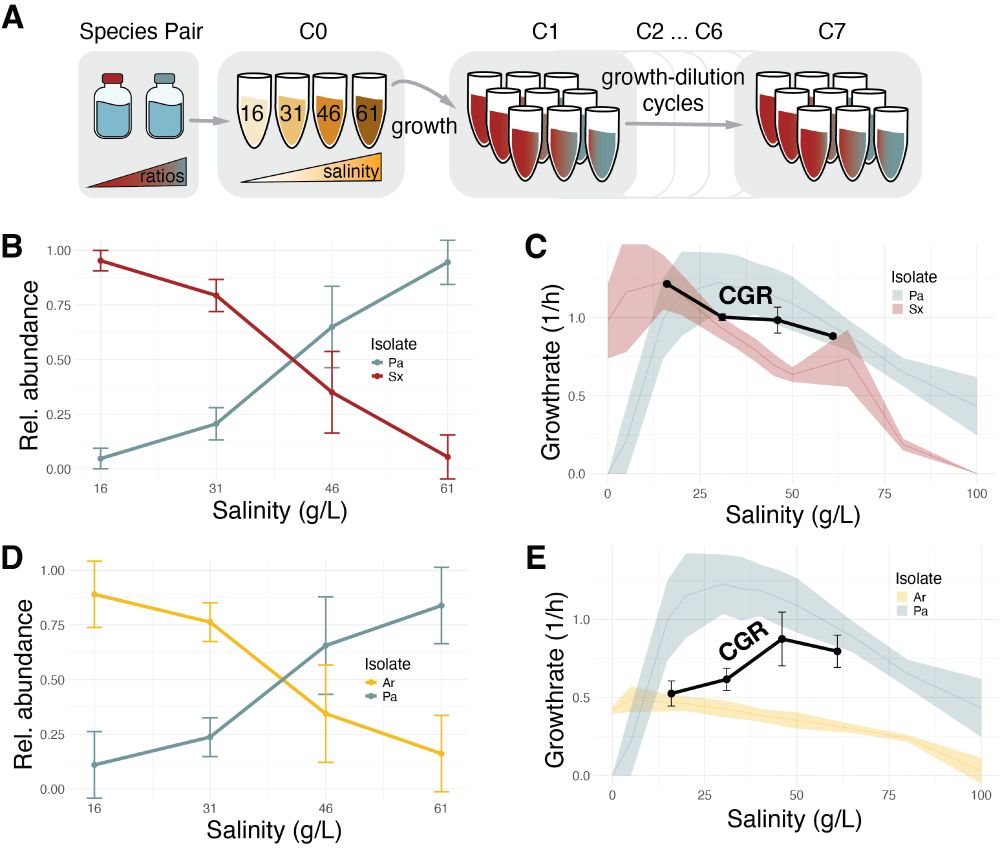Jana Huisman
@jhuisman.bsky.social
HFSP Postdoctoral Fellow at MIT | Mobile genetic elements and microbial communities
Reposted by Jana Huisman
I've used ecoevorxiv.org for perspectives / reviews and liked it.
EcoEvoRxiv
ecoevorxiv.org
September 9, 2025 at 1:32 PM
I've used ecoevorxiv.org for perspectives / reviews and liked it.
In the course of this work, we generated an extensive dataset of "salinity performance curves" for more than 80 bacterial isolates (60 species). We find clear family-level patterns in the relation between max growth rate and salinity.
Stay tuned for more work on this in the near future! (5/5)
Stay tuned for more work on this in the near future! (5/5)

August 25, 2025 at 2:33 PM
In the course of this work, we generated an extensive dataset of "salinity performance curves" for more than 80 bacterial isolates (60 species). We find clear family-level patterns in the relation between max growth rate and salinity.
Stay tuned for more work on this in the near future! (5/5)
Stay tuned for more work on this in the near future! (5/5)
We demonstrate these dynamics in natural aquatic communities propagated in the lab, pairwise competitions between natural isolates, and in metagenomic data of communities sampled across salinity gradients in estuarine environments.
We find the same patterns across all these scales (4/5)
We find the same patterns across all these scales (4/5)

August 25, 2025 at 2:33 PM
We demonstrate these dynamics in natural aquatic communities propagated in the lab, pairwise competitions between natural isolates, and in metagenomic data of communities sampled across salinity gradients in estuarine environments.
We find the same patterns across all these scales (4/5)
We find the same patterns across all these scales (4/5)
This robustness of the community growth rate results from a shift in community composition towards species with higher growth rates at higher salinity.
Modeling shows that this is a general principle, expected for any stressor that reduces the growth rate of most species! (3/5)
Modeling shows that this is a general principle, expected for any stressor that reduces the growth rate of most species! (3/5)

August 25, 2025 at 2:33 PM
This robustness of the community growth rate results from a shift in community composition towards species with higher growth rates at higher salinity.
Modeling shows that this is a general principle, expected for any stressor that reduces the growth rate of most species! (3/5)
Modeling shows that this is a general principle, expected for any stressor that reduces the growth rate of most species! (3/5)
We found that the mean growth rate of the community was surprisingly robust to increasing salinity compared to the growth rates of individual bacteria.
Growth was maintained even when community diversity decreased, highlighting a dilemma in how to assess ecosystem health and functioning. (2/5)
Growth was maintained even when community diversity decreased, highlighting a dilemma in how to assess ecosystem health and functioning. (2/5)
August 25, 2025 at 2:33 PM
We found that the mean growth rate of the community was surprisingly robust to increasing salinity compared to the growth rates of individual bacteria.
Growth was maintained even when community diversity decreased, highlighting a dilemma in how to assess ecosystem health and functioning. (2/5)
Growth was maintained even when community diversity decreased, highlighting a dilemma in how to assess ecosystem health and functioning. (2/5)
A great collaboration that would not have been possible without Shotaro Torii, Htet Kyi Wynn, Irene Voellmy, Michael Huber, @charliegan.bsky.social, @trj2.bsky.social and @viralexplorers.bsky.social

August 22, 2025 at 3:03 PM
A great collaboration that would not have been possible without Shotaro Torii, Htet Kyi Wynn, Irene Voellmy, Michael Huber, @charliegan.bsky.social, @trj2.bsky.social and @viralexplorers.bsky.social


